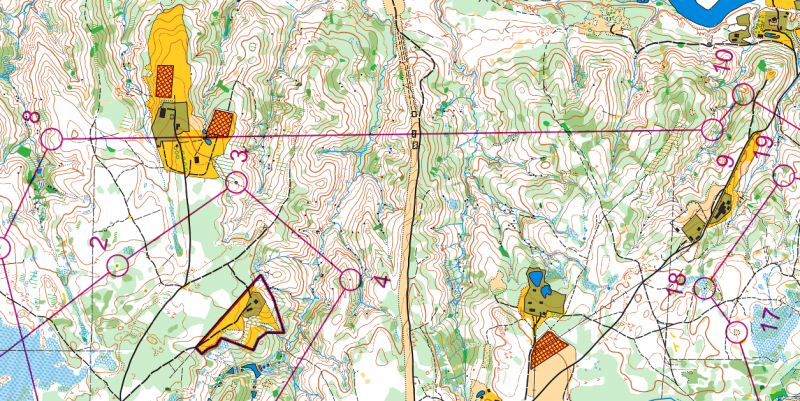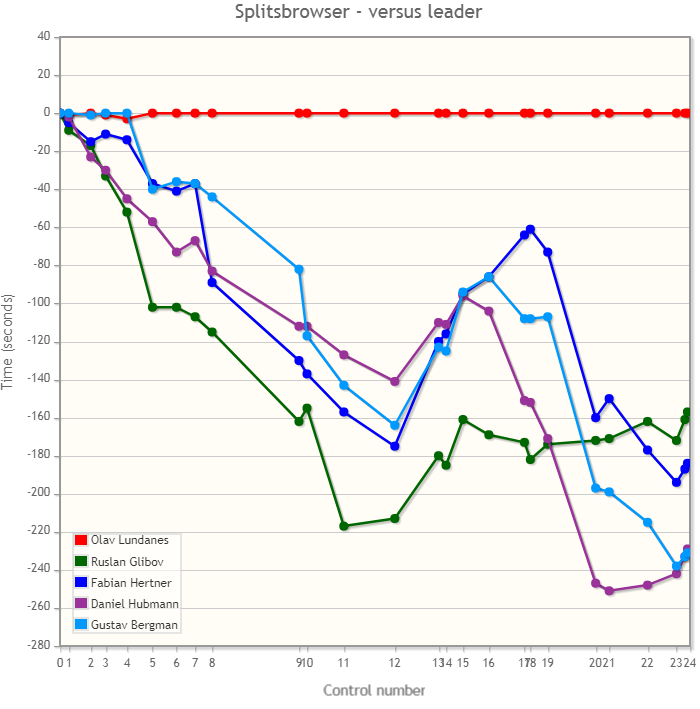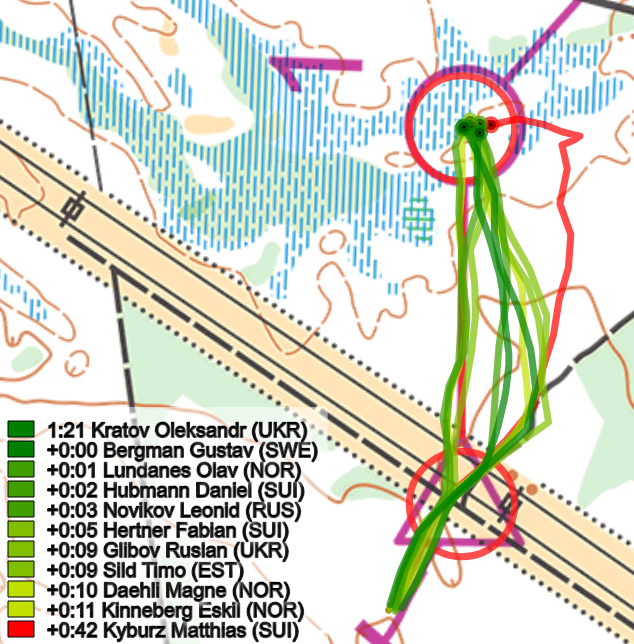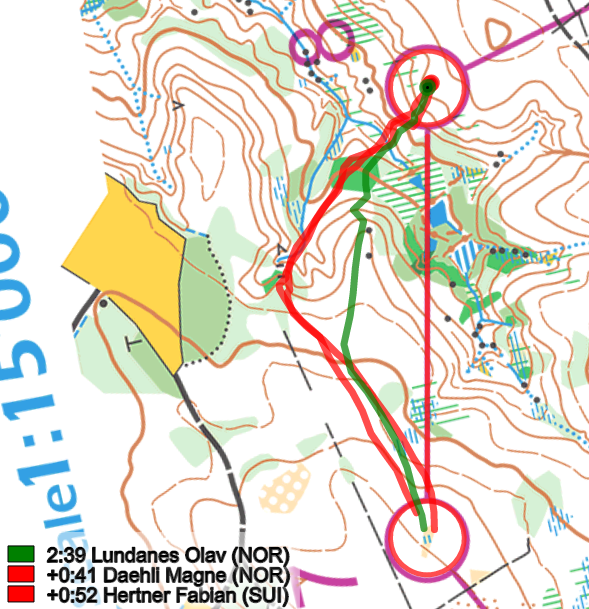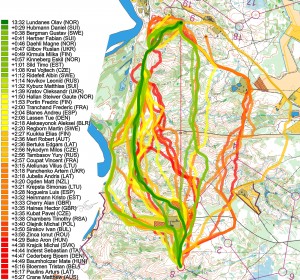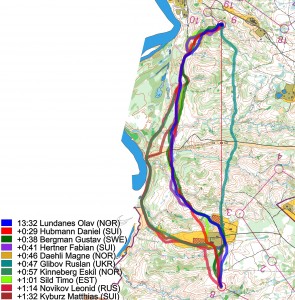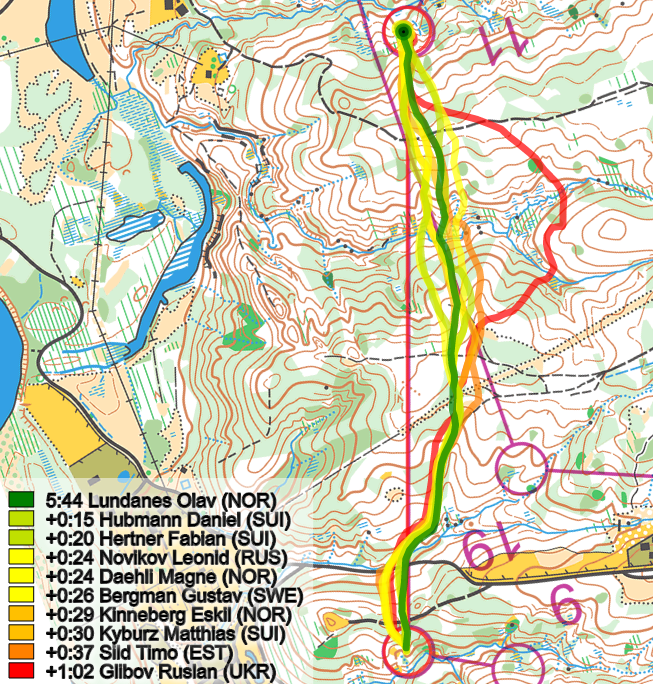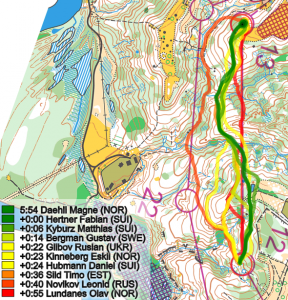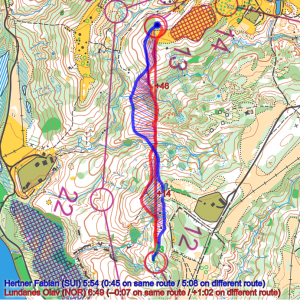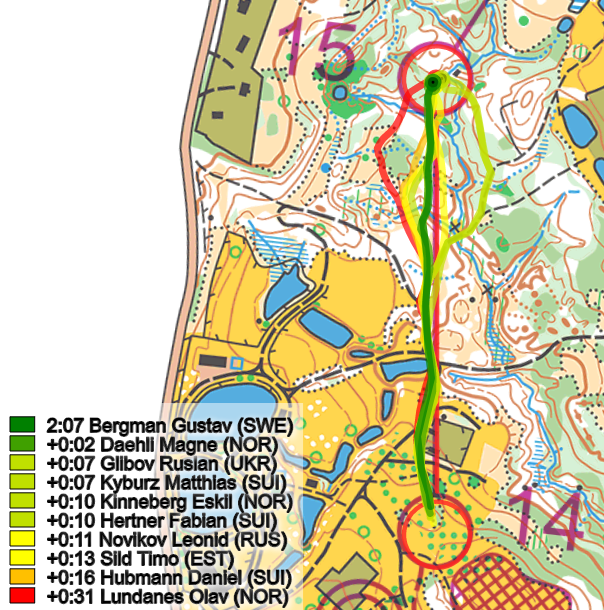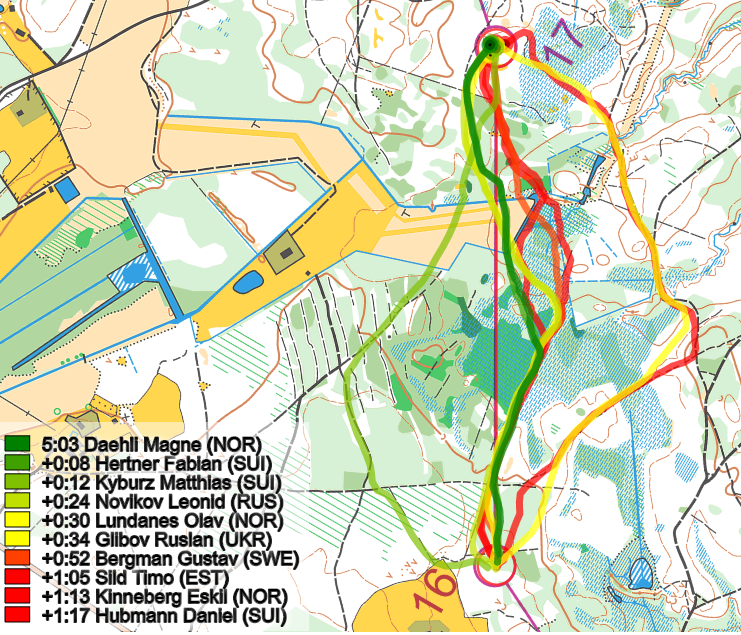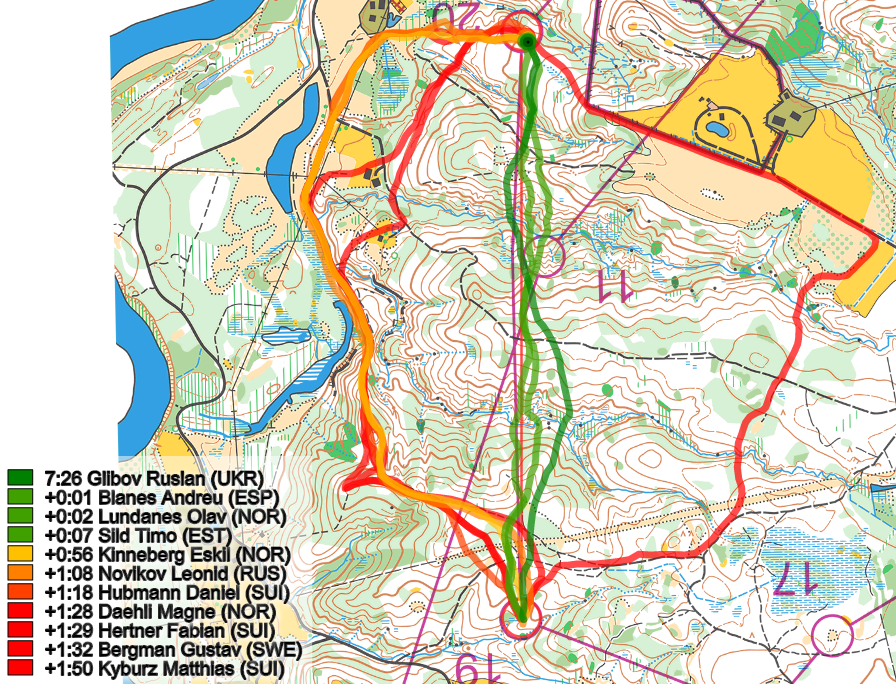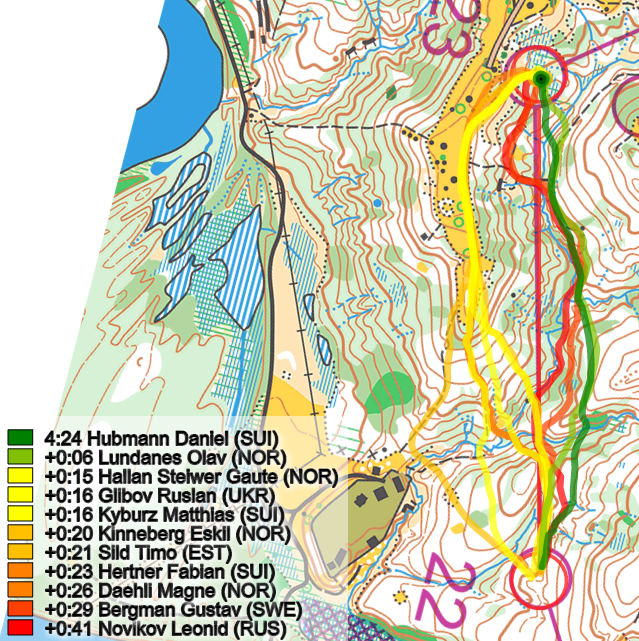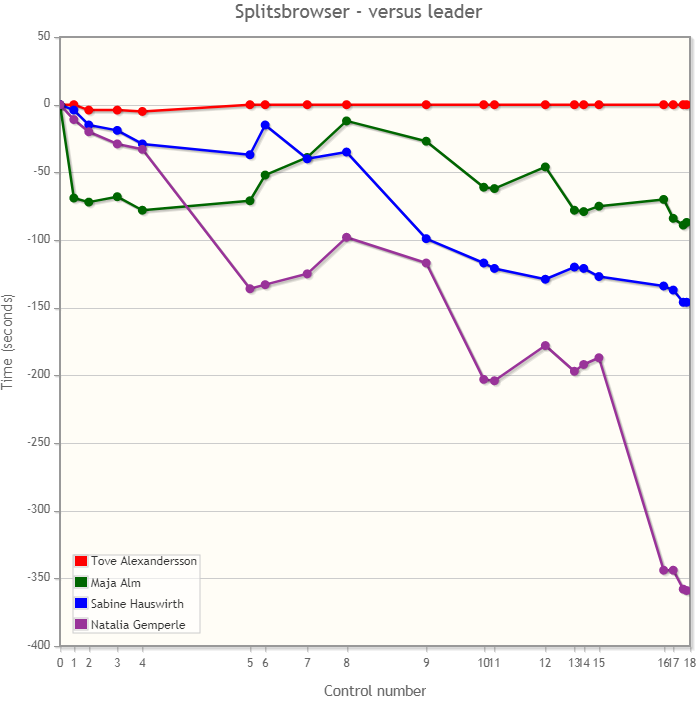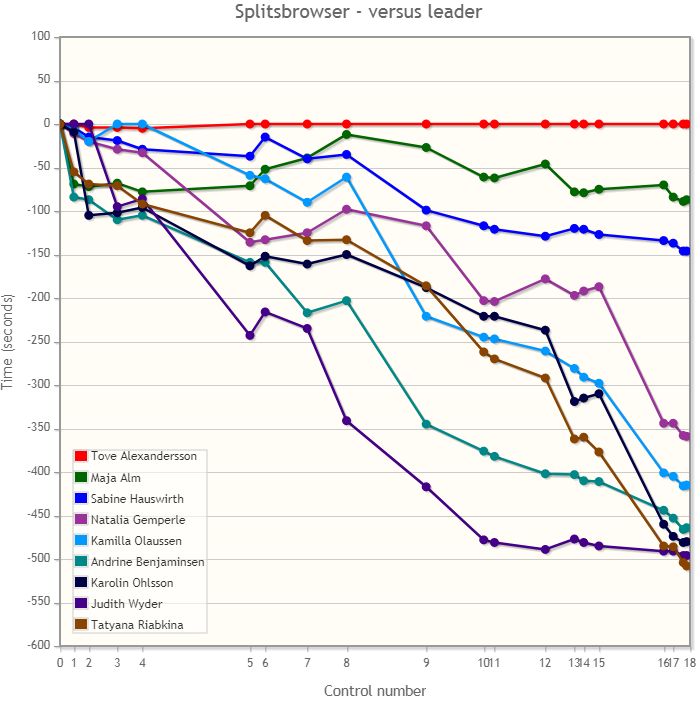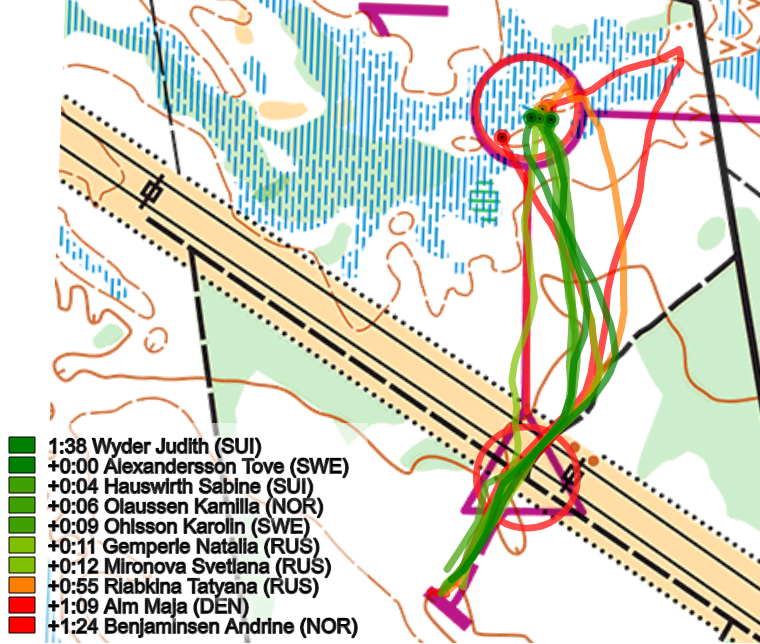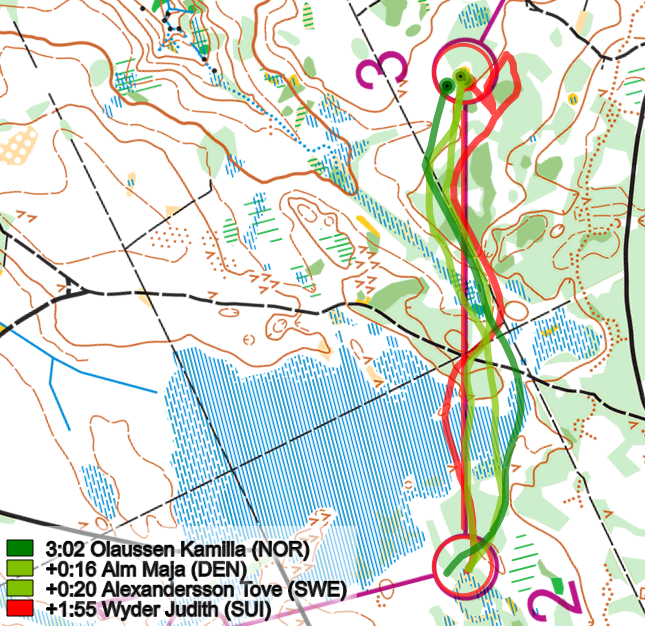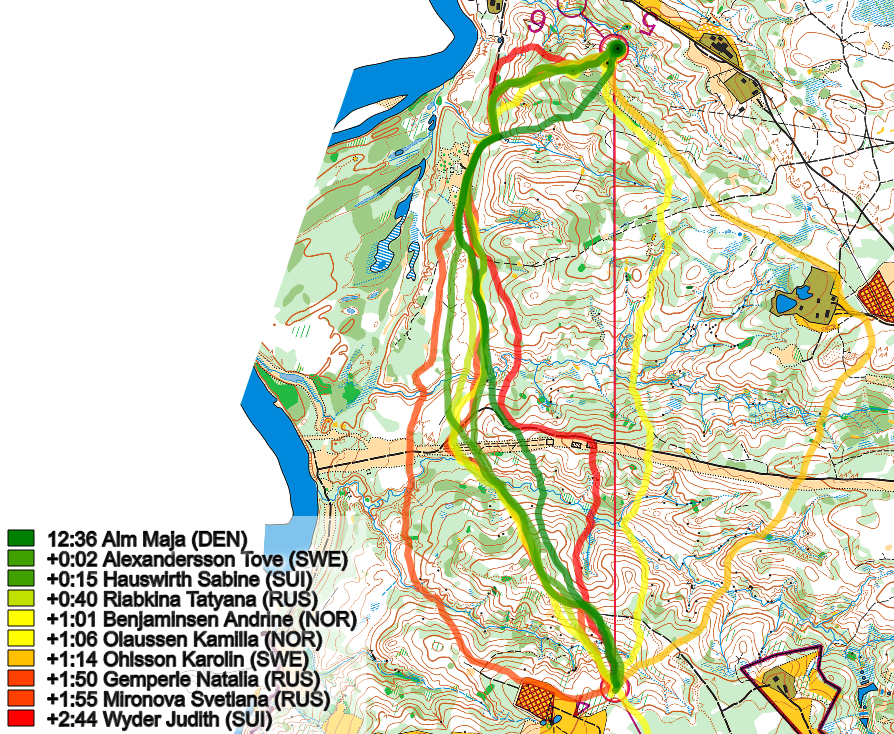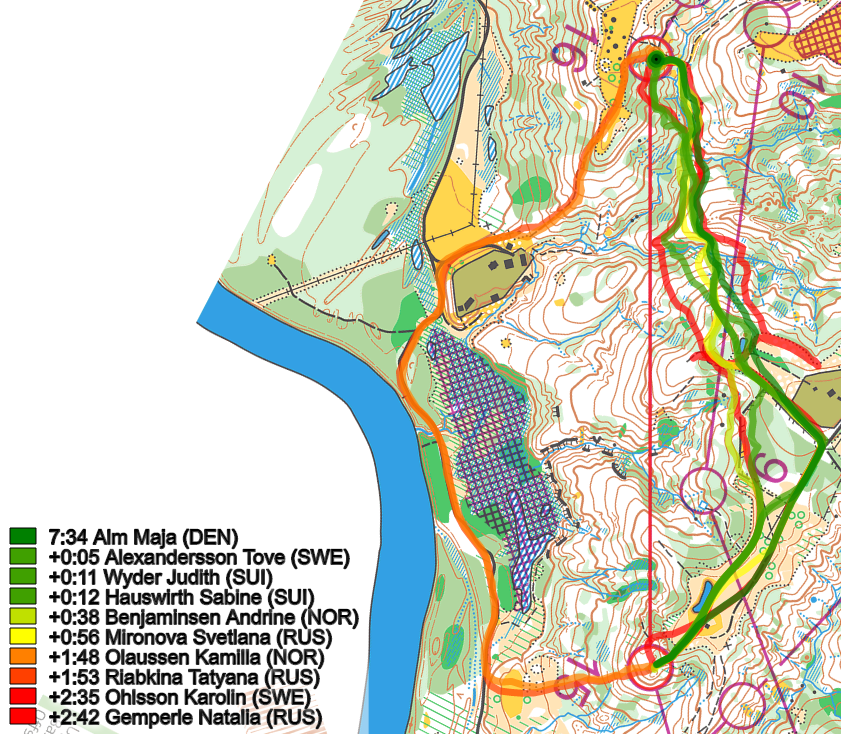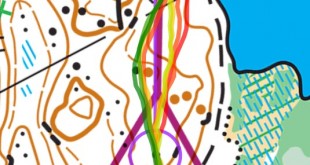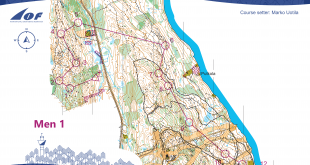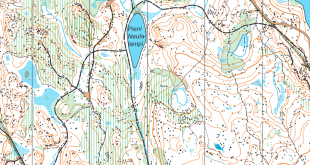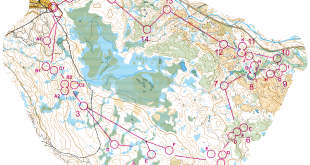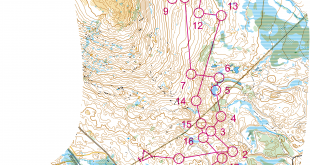[Article updated with GPS-illustrations] Olav Lundanes (Norway) and Tove Alexandersson (Sweden) won the World Orienteering Championships (WOC) 2018 Long distance after exciting races on interesting courses. The courses offered several interesting, longer routechoice legs – and also some intricate orienteering in the dense forest with low visibility.
Both Lundanes and Alexandersson were the big favourites of the day, both taking their third WOC title in a row on the long distance. For Lundanes this was his fifth Gold on the Long distance – the first runner to ever achieve this! Still this was definitely no “walk in the park” for any of them; Lundanes had stomach problems the last days and could not run the relay for Norway and Thursday, and Alexandersson has struggled to run as well as she is capable of so far in Latvia.
A short analysis of the race is included below – a more thorough analysis with more details for the deeply interested ones will follow tomorrow.
Men: Lundanes and Glibov strongest in the end
Lundanes won with a quite big gap in the end – 2:37 minutes ahead of Ruslan Glibov (Ukraine) with Fabian Hertner (Switzerland) in 3rd at 3:04. Gustav Bergman took the lead at the first control. Then the race lead changed between Olav Lundanes (leading at the 2nd control) and Gustav Bergman (leading from the 3rd to 4th control, losing 43 seconds and the lead at the 5th) before Olav Lundanes took over the lead at control 5 of 25 controls and kept it until the finish.
At control 18 the gap down to Hertner in second place was down to less than a minute
Lundanes run very strong in the first part of the race, and had a lead of more than 2 minutes halfway in the race at control 12. From there and until control 18 the Norwegian did have a poorer period physically though, several runners picking time on him until control 18 – here at control 18 the gap down to Hertner in second place was down to less than a minute. From there and on there was no doubt that Lundanes would take the win, however, Hertner losing time towards the end. Ruslan Glibov’s last half of the race was very impressive – here he was the fastest in the field, and this is what secured him the silver medal.
Ruslan Glibov’s last half of the race was very impressive – here he was the fastest in the field, and this is what secured him the silver medal
The below graphical illustration shows the race development for the top 5 runners – and highlights how Glibov (green) passes Hertner, Daniel Hubmann (Switzerland) and Gustav Bergman (Sweden) in the last part of the race. The two most crucial legs to note are the legs from control 8 to 9 and the leg from control 19 to 20. The long leg from 8 to 9 is where Lundanes builds up a gap to most of his competitors, whereas the leg from 18 to 19 is where Lundanes and Glibov decided against the others by taking a better routechoice.
The two most crucial legs to note are the legs from control 8 to 9 and the leg from control 19 to 20.
Another illustration showing the other runners battling for the medals is also shown below. Notable is Leonid Novikov‘s “fall” from a silver position and out of the medal battle due to a far too long routechoice to control 12.
Here is an animation of the race development (via Twitter):
See #GPSanimation of how Olav Lundanes 🇳🇴 takes his third WOC Long GOLD🥇in a row at #WOC2018 in an exciting race. Ruslan Glibov 🇺🇦 took silver with a very strong finish, Fabian Hertner 🇨🇭bronze and first to take medals in all disciplines #orienteering pic.twitter.com/9FinX8nYc9
— WorldofO.com (@worldofo) August 11, 2018
GPS-Illustrations from the men’s course
Kyburz loses 40 seconds already to the first control – and struggled all the way technically. Long distance is the only discipline were Kyburz does not yet have a medal – and he did not manage this year either.
Glibov, Dæhli and Bergman all lose time to control 5, missing on the first control in the dense forest.
Hertner and Dæhli lose 40-50 seconds on a non-optimal route (wrong direction) to control 8. They are together at this point on the course (Hertner caught Dæhli at control 6) – at this point in the course Hertner is the one running in front.
On the long leg to control 9 Olav Lundanes makes one of his best performances on this course, winning the leg with nearly half a minute to Gustav Bergman. Ruslan Glibov chooses a direct route which he performs in an excellent way, losing only 47 seconds to Lundanes. Kyburz and Novikov run to the left too early, losing more than a minute to Lundanes.
Another non-optimal routechoice by Glibov to control 11 – he tries to save some climb, but this is too far around for this climb.
Leonid Novikov loses the medal chances on this strange, long routechoice to control 12 – this is definitely too long! Novikov is less than 3 minutes from silver, and loses 3:05 to Glibov on this leg. Close but no cigar..
The leg to 13 is Lundanes’ worst leg, losing nearly minute to Hertner. Here it starts to look a big dangerous for Lundanes for the first time in the race.
Another timeloss of half a minute for Lundanes, Hertner is getting even closer…
Several top runners lose tim to control 17 – Lundanes also loses another 22 seconds to Hertner. At this point Dæhli is starting to get strong towards the end of the course and is pushing ahead of Hertner (they are still together).
The crucial leg on the course – the leg to control 20. Of the top runners only Lundanes, Glibov and Sild run straight. All the other run either right (Kyburz) or left (the rest) and lose a minute or more! This is were Lundanes decides for certain – and also where Glibov secures his medal.
Several also lose time to control 23, at the very end of the course. Only Hubmann and Lundanes run to the right and perform well, probably exploiting some knowledge from the relay. Bergman loses the 4th place to Hubmann here.
Women: Alexandersson versus Alm
Alexandersson won 1:27 minutes ahead of Maja Alm (Denmark) with Sabine Hauswirth (Switzerland) in 3rd at 2:26. Tove Alexandersson took the lead at the first control. Then the race lead changed between Judith Wyder (leading at the 2nd control, losing 1:55 at the 3rd control and falling down to 19th place) and Kamilla Olaussen (leading from the 3rd to 4th control, losing 1:06 and the lead at the 5th) before Tove Alexandersson took over the lead at control 5 of 19 controls and kept it until the finish.
Maja Alm did her largest mistake already to the first control, losing 1:09 to Tove Alexandersson due to a mistake on a quite easy control in flat, open forest
Maja Alm did her largest mistake already to the first control, losing 1:09 to Tove Alexandersson due to a mistake on a quite easy control in flat, open forest – that was nearly all of the gap Alm had to Alexandersson in the end. Except for this mistake at the start, the two runners followed each other closely all the way, as the below graphical illustration of the race shows. Sabine Hauswirth in third did a stable and good race- her biggest timeloss was 1:04 on the long leg to control 9 where she took a good routechoice but did not have optimal execution. Natalia Gemperle (Russia) was one of the big pre-race favourites after her victory on the middle distance, but she struggled with routchoices and execution on the long legs to 5, 10 and 16 – and finished only in 4th after definitely having the speed for a medal.
Below a graphical illustration of the split times of all the Top 9-runners is shown. Clearly the longer legs to 5, 9 and 16 were very decisive for the outcome in the race – several of the Top10-runners lost significant time here, including Judith Wyder, Kamilla Ollaussen and Andrine Benjaminsen.
Here is an animation of the race development (via Twitter):
See #gpsanimation of how Tove Alexandersson 🇸🇪 wins #woc2018 Long ahead of Maja Alm 🇩🇰 and Sabine Hauswirth 🇨🇭! Note especially Alm's mistake at control 1 and how Gemperle, Olaussen, Ohlsson lose time on long leg to 6 #orienteering pic.twitter.com/lFIAFsukYD
— WorldofO.com (@worldofo) August 11, 2018
GPS-Illustrations from the women’s course
Three of the Top-10 finishers made a mistake of 55 seconds or more to the first control – this is were Alm loses most of the time she is behind Alexandersson.
Wyder loses nearly two minutes on a mistake on control 3.
Wyder, Gemperle and Mironova lose 1:50 or more on the long leg to control 6; Gemperle runs too far to the left, Wyder first runs straight and then changes over to the left route, Mironova has bad execution but good route. Olaussen and Ohlsson also lose more than a minute here by running direct and to the right, respectively. Definitely an interesting leg where lots of different routes were run.
And a nice animation showing all the different routes chosen:
Nice long routechoice leg in #WOC2018 Long in the women's class to control 6! pic.twitter.com/55aZPDKcOg
— WorldofO.com (@worldofo) August 11, 2018
Another routechoice miss for Wyder to control 8 – going around to the left here is simply not a good idea.
To 9 we have another routechoice leg. Here going to the right is fastest – and in addition easier to execute. The two Norwegians Benjaminsen and Olaussen lose more than 2 minutes on going left, mostly due to bad execution. Olaussen also has a small miss in the control circle.
To 16 it is definitely too far to run around to the left as Olaussen and Riabkina do, losing around 1:50 both of them. Gemperle does a strange miss of nearly 3 minutes on the middle of the leg. Ohlsson also has bad execution and loses nearly 3 minutes.
Maps and GPS-tracking
In addition to the maps/GPS-tracking below, see also the WOC 2018 Women Long Course Preview-article written just as the first runners started to give a preview on some of the challenges.
WOC 2018 Long Men

» See map in omaps.worldofo.com
WOC 2018 Long Women

» See map in omaps.worldofo.com
Results
Men
| 1 | Olav Lundanes | 1:37:43 | 6:04 | ||
| 2 | Ruslan Glibov | 1:40:20 | +2:37 | 6:13 | |
| 3 | Fabian Hertner | 1:40:47 | +3:04 | 6:15 | |
| 4 | Daniel Hubmann | 1:41:32 | +3:49 | 6:18 | |
| 5 | Gustav Bergman | 1:41:34 | +3:51 | 6:18 | |
| 6 | Eskil Kinneberg | 1:42:35 | +4:52 | 6:22 | |
| 7 | Magne Daehli | 1:42:47 | +5:04 | 6:23 | |
| 8 | Matthias Kyburz | 1:43:12 | +5:29 | 6:24 | |
| 9 | Leonid Novikov | 1:43:19 | +5:36 | 6:25 | |
| 10 | Gernot Ymsen Kerschbaumer | 1:43:45 | +6:02 | 6:26 | |
| 11 | Timo Sild | 1:44:30 | +6:47 | 6:29 | |
| 12 | Gaute Hallan Steiwer | 1:44:31 | +6:48 | 6:29 | |
| 13 | Vojtech Kral | 1:45:17 | +7:34 | 6:32 | |
| 14 | Albin Ridefelt | 1:45:47 | +8:04 | 6:34 | |
| 15 | Miika Kirmula | 1:47:25 | +9:42 | 6:40 | |
| 16 | Frederic Tranchand | 1:49:24 | +11:41 | 6:47 | |
| 17 | Tue Lassen | 1:50:31 | +12:48 | 6:51 | |
| 18 | Martin Regborn | 1:50:46 | +13:03 | 6:52 | |
| 19 | Oleksandr Kratov | 1:51:10 | +13:27 | 6:54 | |
| 20 | Andreu Blanes | 1:51:18 | +13:35 | 6:54 |
Women
| 1 | Tove Alexandersson | 1:14:04 | 7:28 | ||
| 2 | Maja Alm | 1:15:31 | +1:27 | 7:37 | |
| 3 | Sabine Hauswirth | 1:16:30 | +2:26 | 7:43 | |
| 4 | Natalia Gemperle | 1:20:03 | +5:59 | 8:05 | |
| 5 | Kamilla Olaussen | 1:20:59 | +6:55 | 8:10 | |
| 6 | Andrine Benjaminsen | 1:21:48 | +7:44 | 8:15 | |
| 7 | Karolin Ohlsson | 1:22:04 | +8:00 | 8:17 | |
| 8 | Judith Wyder | 1:22:20 | +8:16 | 8:18 | |
| 9 | Tatyana Riabkina | 1:22:32 | +8:28 | 8:20 | |
| 10 | Svetlana Mironova | 1:23:38 | +9:34 | 8:26 | |
| 11 | Marianne Andersen | 1:23:55 | +9:51 | 8:28 | |
| 12 | Miri Thrane Oedum | 1:26:35 | +12:31 | 8:44 | |
| 13 | Sofia Haajanen | 1:26:48 | +12:44 | 8:46 | |
| 14 | Lisa Risby | 1:30:28 | +16:24 | 9:08 | |
| 15 | Vendula Horcickova | 1:31:39 | +17:35 | 9:15 | |
| 16 | Marika Teini | 1:32:27 | +18:23 | 9:20 | |
| 17 | Jana Knapova | 1:32:35 | +18:31 | 9:21 | |
| 18 | Inga Dambe | 1:33:11 | +19:07 | 9:24 | |
| 19 | Anna Serrallonga Arques | 1:33:38 | +19:34 | 9:27 | |
| 20 | Annika Rihma | 1:34:09 | +20:05 | 9:30 |
 World of O News
World of O News
